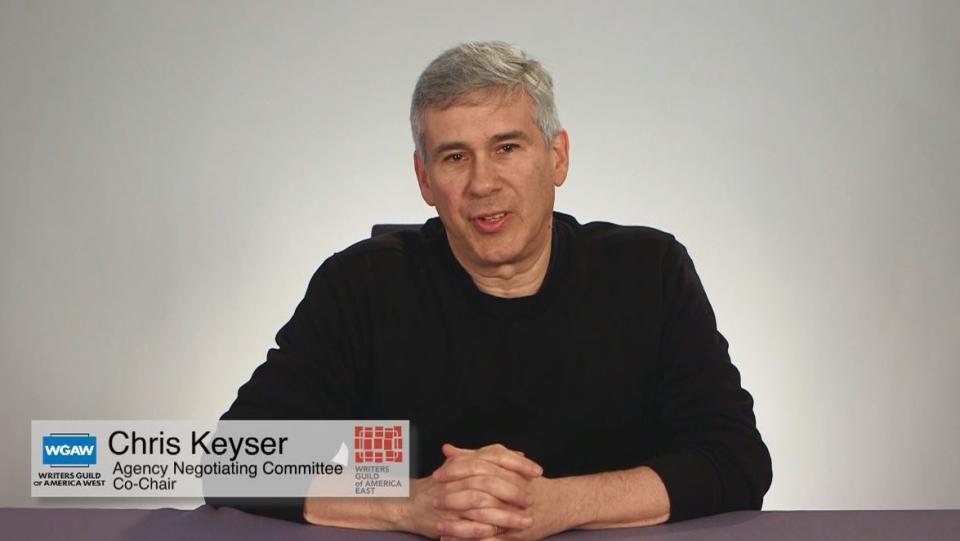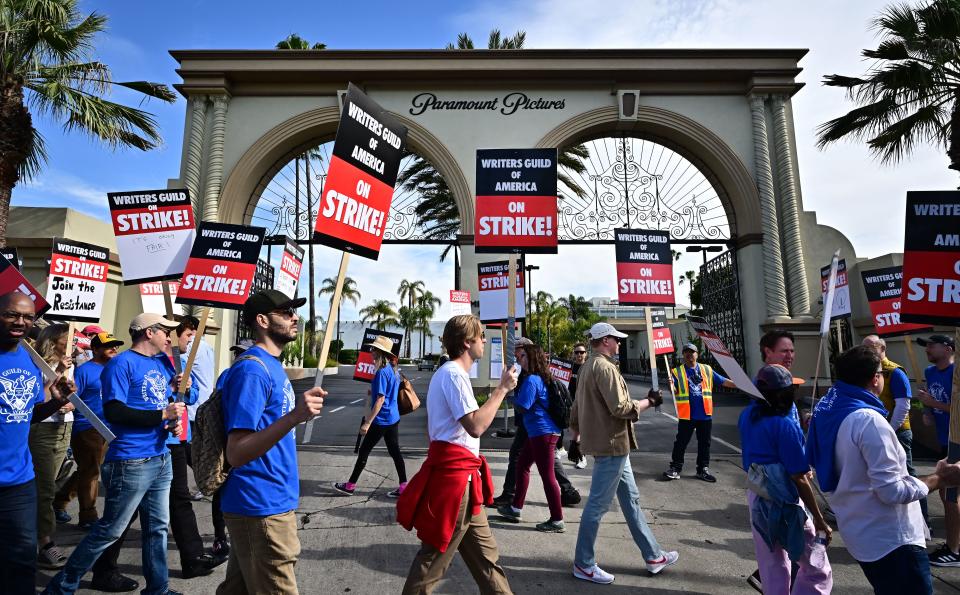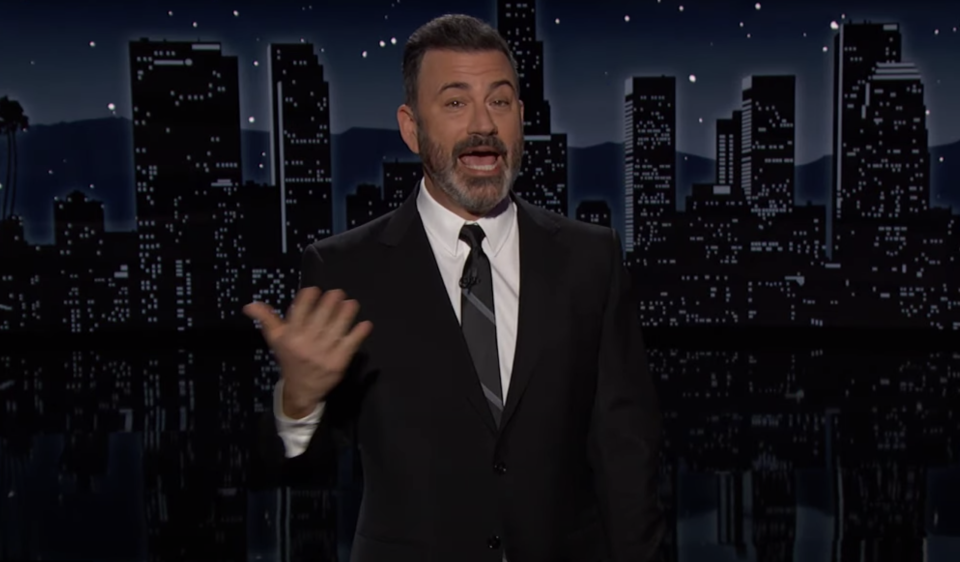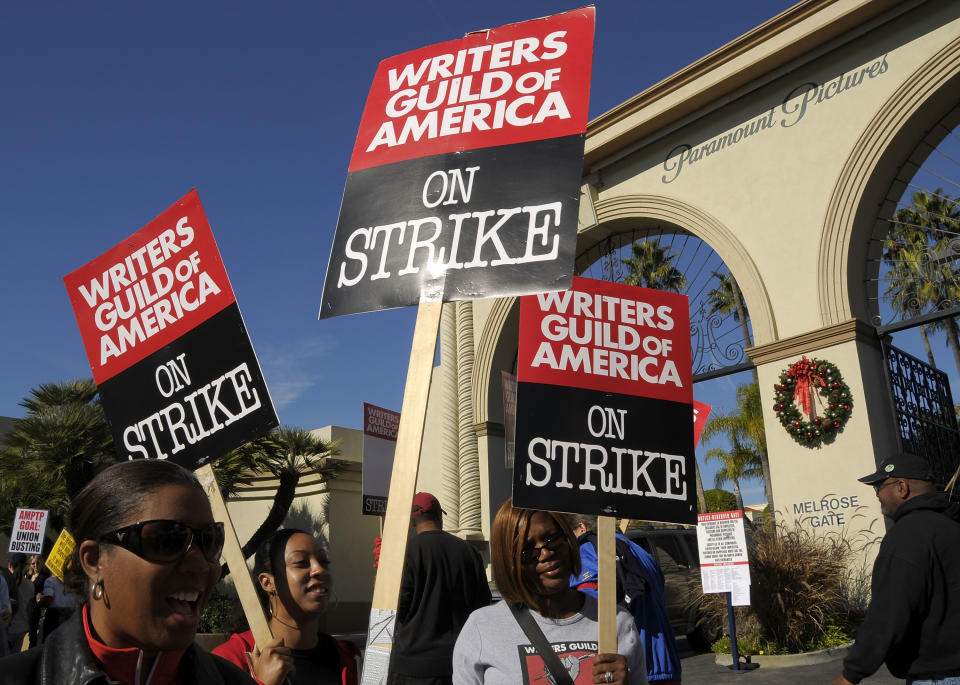WGA Strike Explained: The Issues, The Stakes, Movies & TV Shows Affected — And How Long The 2023 Work Stoppage Might Last

UPDATED with the latest: Hollywood has been a union town for close to 100 years. In that time, there have been a little over a dozen major labor strikes, the last being the 2007-08 Writers Guild of America work stoppage, which lasted 14 weeks and had a profound impact on the industry.
RELATED: Deadline’s Full Strike Coverage
More from Deadline
The WGA strike started at 12:01 a.m. PT Tuesday, a minute after its contract with the Alliance of Motion Picture and Television Producers expired. The guild confirmed that the strike indeed would happen about three hours prior to the midnight deadline.
Below is a primer covering the issues, the parties involved and what’s at stake for the entire industry during the work stoppage.
In Brief
Deadline: 11:59 p.m., May 1
At Issue: Compensation for writers in a changing media landscape
Jobs At Stake: 822,000 direct employees; 2.4M total supported in 2021
Industry Wages: $81B direct; $186B total supported
The Market: $261B in sales
WGA Membership: ~20,000
AMPTP Membership: 350-plus TV and film production companies
More: WGA Strike Picket Line Locations List For Los Angeles & New York
The Two Sides
On one side are the Hollywood studios, networks, streamers and hundreds of other motion picture and TV producers which make and/or distribute most content. They are represented in the talks by the Alliance of Motion Picture and Television Producers.
On the other is the Writers Guild of America, which represents writers in Hollywood who are members, which most working scribes are. Supporting the WGA are many of the other powerful guilds and unions, including the SAG-AFTRA and the Directors Guild of America (DGA).

What’s at Issue?
“The survival of writing as a profession is at stake in this negotiation,” the WGA said at the outset, noting that many members who previously made a good living are finding it much harder to do so these days.
“Driven in large part by the shift to streaming, writers are finding their work devalued in every part of the business. While company profits have remained high and spending on content has grown, writers are falling behind,” the WGA said in a statement. “The companies have used the transition to streaming to cut writer pay and separate writing from production, worsening working conditions for series writers at all levels. “
In its strike declaration, the guild was more explicit, asserting that the AMPTP is essentially out to create “gig economy” work out of what once were full time careers:
“The companies’ behavior has created a gig economy inside a union workforce, and their immovable stance in this negotiation has betrayed a commitment to further devaluing the profession of writing. From their refusal to guarantee any level of weekly employment in episodic television, to the creation of a “day rate” in comedy variety, to their stonewalling on free work for screenwriters and on AI for all writers, they have closed the door on their labor force and opened the door to writing as an entirely freelance profession. No such deal could ever be contemplated by this membership.”
There is also the potentially-transformative impact of AI, and how it could be used to generate scripts.
WGA Negotiating Committee Co-Chair Chris Keyser told Deadline in a picket-line interview that the studios would not broach the subject.
“They would not discuss AI. I think you get a really good sense from the companies about where they see the future based on what they say they won’t talk about. Because the stuff they’ll say yes to is the stuff they feel like they can absorb so easily, or maybe not pay in the long run.”
Keyser continued, “Right now, I think we have a pretty simple philosophy, which is AI can’t be literary material. It can’t be a draft that we have to rewrite. It doesn’t mean that companies won’t use it in some ways. It can be research material — but it can’t be literary material. I’ll say this, no one knows exactly what AI’s going to be, but the fact that the companies won’t talk about it is the best indication we’ve had that we have a reason to fear it.”
The AMPTP, for its part, is taking a conservative approach not just in communication with the WGA and media, but also in representing the interests of its members with an eye to their bottom lines and stock prices. AMPTP President Carol Lombardini is widely seen as a tough but fair negotiator. She wants the best for her side, and that’s a deal that sees production continue to flow and flourish and helps studios and streamers keep their costs under control.

What’s at Stake?
Hollywood is just emerging from the impacts of Covid and the related production slowdowns. More recently, studios, networks, streamers and producers have laid off thousands of workers. For an industry that a year ago was collectively questioning its own future, a strike-related work stoppage after layoffs and Covid-related shutdowns could prove a staggering three-punch combination.

What Do Writers Want?
Specifically, with the current strike, the WGA seeks gains in compensation and residuals, and curbs on mini-rooms, where groups of writers work in advance of the production of a television series to break stories and write scripts. The guild has argued that the producers are well able to compensate writers more fairly. Get much more detail here.
“The entertainment segments of the industry’s major companies — Netflix, Paramount Global, Warner Bros. Discovery, Fox, Disney, and Comcast/NBCUniversal — posted an average $29 billion in annual operating income between 2017 and 2021,” it said in a recent report. “Legacy media companies’ profits in 2022 were lower, but the companies expect improvement in the near term as they build towards increased profitability in streaming.” (Note: the AMPTP also represents Apple and Amazon, in addition to the companies listed above.)
The guild also wants to establish some sort of policy on AI and authorship, especially if a writer’s ideas are used as the basis for AI-generated work.
“The WGA’s proposal to regulate use of material produced using artificial intelligence or similar technologies ensures the Companies can’t use AI to undermine writers’ working standards, including compensation, residuals, separated rights and credits,” it noted.
For a detailed list of the WGA’s specific goals see its Pattern of Demands, listed here.
More: What Went Wrong? Writers & Studios Reveal What They Couldn’t (And Could) Agree On & The WGA Takes On AI, Laying Out Its Position
What Do Studios, Networks & Streamers Want?
Quite simply, they want to make sure that they can keep making a profit.
One line of argument from producers says that streaming is still an emerging business and studios and networks don’t exactly know what profit margins will look like (or even how they will be achieved). But Netflix co-CEO Ted Sarandos recently estimated his company’s expected content spend for 2024 at $17 billion and reported Q1 free cash flow that zoomed to $2.1 billion compared with $800 million in the year-ago quarter. That’s a pretty healthy “emerging” business.
Officially, the AMPTP has been more vague about its goals, beyond the desire to see production continue. One recent statement from the group read, “We are all partners in charting the future of our business together and fully committed to reaching a mutually beneficial deal with each of our bargaining partners. The goal is to keep production active so that all of us can continue working and continue to deliver to consumers the best entertainment product available in the world.”

What TV Shows Would Be Affected?
Late-night shows were the first hit. The Late Show with Stephen Colbert, Jimmy Kimmel Live! and The Tonight Show Starring Jimmy Fallon all went dark on Tuesday, given their nightly schedules and topical nature. During the 2007-08 strike, all the late-night talkers began airing reruns on Day 1.
Some good news: Staffers on The Tonight Show Starring Jimmy Fallon and Late Night with Seth Meyers can breathe slightly easier after the hosts and the networks worked out plans to pay crew for at least a few weeks.
Saturday Night Live has also gone dark, impacting the last three shows of the season including the Pete Davidson-hosted show on May 6 as well as the season finale, where departing castmembers traditionally get to say their goodbyes. The Talk has also shut down.
Other examples are emerging. For instance, NBC’s Night Court is currently in production on its second season. The sitcom is off this week but was supposed to resume filming next week, sources tell Deadline. As a multi-camera comedy, that is impossible without writers given the amount of tweaks made ahead of and during taping, so the series is expected to go dark for the time being.
Next to be impacted will likely be Daytime TV — especially soap operas, which generally have an ongoing production schedule.
One arena that will not be affected is professional wrestling. WWE CEO Nick Khan said Wednesday the company isn’t impacted by the WGA strike.
“Our writers are not members of the guild,” he said (yes, wrestling is scripted!). “So there is no effect on us whatsoever. Of course we are supportive of the writers who are members of the guild and their efforts.”
At some point, other hit episodic shows could be impacted. Per a recent WGA report, “a work stoppage in May could delay the network television season, which continues to account for one third of all episodes produced, including 45% of the episodes produced by legacy media companies Disney, Paramount Global, and Comcast NBCUniversal. Writers on fall network series typically begin work in May and June in preparation for series premieres inSeptember and October. Writing for numerous streaming series is also ongoing or is anticipated to begin in the coming months. Any delay in the start of work has the potential to postpone fall season premieres and could ultimately reduce the amount of new programming produced for
the 2023-2024 network season.”
When that blow fell in the 2007-2008 strike, networks leaned into a then relatively-nascent genre of programming: unscripted. What resulted was an explosion of reality TV and new formats, many of which are still with us today. It could have an even larger impact this time, further accelerating the decline of scripted programming on linear television.
The broadcast business has been at a crossroads for the past couple of years, putting emphasis on live programming, sports and unscripted fare as scripted series increasingly are consumed digitally on-demand. The WGA strike could well hasten the process, according to a number of industry sources.
Fox finished as fall’s No.1 broadcast network among adults 18-49 for the first time in a decade bolstered by The Masked Singer, Thursday Night Football, the World Series and WWE Smackdown. With more than 40% of Fox’s schedule devoted to sports/reality program, we may be taking a glimpse at what the typical programming mix on the Big 4 could look like in the near future.
More: Late-Night Shows Shut Down Immediately After Strike Called & Writers’ Strike Could Accelerate Scripted Programming’s Decline On Linear Television

Impact On Movies
In a worst-case scenario, the theatrical release calendar would see several date changes for pics, some as soon as Q4 this year. While the 2024 theatrical release calendar remains roughly intact in its first six months with completed movies coming down the pipeline, beyond that gets squishy; It’s in this scenario that studios might need to pull from Q4 2023 into 2024.
A delay in production could potentially cause another post-production logjam, which was one of the knock-on effects of postponements during the pandemic. That left the late August-October 2022 box office and winter this year a dry bed for product. In fact, we’re still waiting on movies delayed by the pandemic to hit theaters. Warner Bros/DC’s The Flash, which got its first screening at CinemaCon on Tuesday night, and Aquaman and the Lost Kingdom, set for December 20, were two such titles.
Studio and distribution marketing chiefs remain in wait-and-see mode regarding blockbusters, but smaller movies that are publicity-dependent are prime to pivot should SAG-AFTRA strike.
One upcoming feature production that is safeguarding itself from a lengthy WGA strike is James Gunn’s Superman: Legacy, which is planning an early 2024 start for a July 11, 2025 theatrical release. Gunn showed off a cover of the screenplay on social media and announced the start of pre-production earlier this week, with “costumes, production design, and more now up and running.”
More: How A WGA Strike Could Shake Up The Theatrical Release Schedule
What Went Wrong With The Talks?
Many of the biggest issues were in TV, such getting more writers on set and what the studios are referring to as “mandatory staffing” and the WGA is calling “preserving the writers’ room.”
The AMPTP rejected this with studio sources saying that this was difficult because it could last for months, particularly at the streamers, where they often don’t greenlight a show until all of the scripts are written. Also a point of contention were shows written entirely by one person, like The White Lotus. How would staffing quotas work on those?
Elsewhere, on residuals, the guild was asking for 6%-5%-5% increases over the course of a new three-year contract for all minimums including residual bases. But according to the guild, the AMPTP only offered 4%-3%-2% (one-time increase to most residual bases of 2% or 2.5%)
Before the talks broke off, however, the two sides had reached tentative agreements on several issues, including script fees for staff writers; improvements in the guild’s span provisions, which offer protection against the erosion of over-scale pay for writer-producers on short-order series, and an easing of burdensome options and exclusivity provisions that hold staff writers long-term without pay.
The two sides were very far apart on money issues, however. The guild wants to see pay and benefits increased by $429 million over three years, but says that the studios only offered $86 million.
See a summary from the WGA of what each side offered in negotiations here.
More: Writers & Studios Reveal What They Couldn’t (And Could) Agree On As Strike Is Set

How Long Could It Last?
The longest WGA strike on record was 1988, lasting 153 days, followed by the 1960 strike at 146 days, and then the 2007-08 strike at 100 days. There seems to be even more support for a strike this time around.
Back in 2017 – the last time a strike authorization was taken – it was approved by 96.3% of the 6,310 writers who cast ballots, with a record 67.5% turnout of eligible WGA members. In 2007, the authorization vote was approved by 90% of voters. The strike authorization this time around was approved by nearly 98% of the eligible voting members.
Asked if this work stoppage could go on longer than the one in 2007-2008, WGA Negotiating Committee Danielle Sanchez-Witzel (My Name Is Earl) told Deadline, “I can’t say. I know we’re in a day-to-day situation. And I don’t want to speculate and talk about how long this will be because we just don’t know. What I do know is that we are extremely united, all writers across all of our industry…We’re extremely united, we’re fighting for each other.”
Of course, if SAG-AFTRA and the DGA also go on strike, that could impact the length of the work stoppage drastically.
More: WGA Members Vote Overwhelmingly To Authorize A Strike
It’s Not Just The WGA
A number of unions have contracts with the AMPTP expiring in the next few weeks. Generally, the guild that negotiates first sets the tone for the subsequent negotiations. The DGA has gone first at the bargaining table in each of the past three bargaining cycles. The last time the WGA went first — back in 2007 — resulted in a 100-day writers strike.
The powerful DGA begins negotiations for its 19,000 members on May 10. Its contract expires June 30. Like the WGA, streaming residuals are on the DGA’s bargaining agenda, specifically residuals for shows and movies streamed internationally.
“Today, the vast majority of SVOD subscriber growth is based abroad and many of the streaming services’ business models are now focused on global growth,” the DGA said in a statement. “As we prepare to bargain for a strong and modern contract, we’re committed to negotiate a residual formula that provides our fair share of the global growth of this industry and the distribution of our work around the world.”
SAG-AFTRA begins negotiations with the AMPTP on June 7. Its contract with the AMPTP expires on June 30. Should SAG-AFTRA strike, it would prevent actors from doing publicity on their feature or TV projects, which would have very powerful knock-on effects.
In addition, unions and guilds have come out publicly in support of the WGA, including SAG-AFTRA, the Directors Guild, IATSE, Hollywood’s Teamsters Local 399 and the American Federation of Musicians and the UK Writers Guild.
“These multibillion-dollar corporations – including Amazon, Netflix, Disney, and Apple – invest in highly paid executives and lavish productions,” Teamsters Local 399 brass said in a statement. “They can afford to share the wealth with the writers who create the content we all watch. We are monitoring negotiations closely. This is a shared fight and Teamsters do not cross picket lines.”
SAG-AFTRA was more circumspect, sending the following notice to its members: “If you are contracted to work on a project that continues production while the WGA is on strike, you are legally obligated to continue working by your personal services agreement and the ‘no strike’ clause in our collective bargaining agreements.” Actors can also “continue to audition for work” if they choose to.
The actors’ union also advised its members that “if you as an individual decide not to report to work as required, you may be subject to breach of contract claims or be subject to termination by the Producer.”
IATSE and the Teamsters also have “no strike” clauses in their contracts, but their leaders have told members that their contacts afford the “the legal right” to honor the WGA’s picket lines, if it comes to that.
More: SAG-AFTRA & Teamsters Local 399 Leaders Show Solidarity With WGA & Directors Guild Prepares To Fight For More Global Streaming Residuals

Economic Impact
Concerns about labor unrest and uncertainty surrounding pending corporate restructuring have contributed to a 35.8% plunge in on-location TV production in Los Angeles in the first quarter of 2023 compared with the same period last year.
According to the Motion Picture Association — whose members include Netflix, Paramount, Sony Pictures Entertainment, Universal, Disney and Warner Bros. — 2.4 million people work in jobs supported by the industry, which pays over $186 billion in wages annually. And it’s not just in L.A.
The entertainment industry pays out $21 billion per year to more than 260,000 businesses in cities and small towns across the country, per the MPA. It accounts for $14.4 billion in exports and $7 billion in trade surplus for the U.S.
More: On-Location TV Production In Los Angeles Plunges Amid Strike Jitters
What Happened Last Time?
The big win for the Writers Guild in 2007 was some jurisdiction over new media, which was precedent-setting. Streamers would have to hire WGA writers on shows over certain budgets. Other than that, writers received a new percentage payment on the distributor’s gross for digital distribution. But it came at a cost.
The AMPTP estimated that WGA writers and IATSE union members lost $342.8 million in wages in the 2007-2008 work stoppage. The New York Times reported that the overall hit to the Los Angeles economy was $2.1 billion, including an $830 million bite out of statewide retail sales as entertainment workers trimmed spending.
The “Big Four” networks — CBS, ABC, NBC, and FOX — suffered, too. NBC had the most severe ad shortfall with its prime time ratings declining sharply. None of its new shows achieved breakout success. Moreover, during 2007, NBC saw its prime time 18-to-49-year-old viewership drop by 11%. CBS dropped the same demographic by 10%, and ABC lost 5%, according to Crain’s New York Business.
A white paper released by Nielsen Media Research indicated that TV viewers spent more time with alternative forms of entertainment outside of broadcast television, a trend that may accelerate this time around given the massively-increased prevalence of social media, chat and short-video consumption since then.
One SNL source told Deadline that during the 2007-08 strike there was a real question whether the venerable NBC show would ever come back. “It was especially heartbreaking because the show was in really great place then. But at the same time, it was absolutely right. There’s no way to do SNL during a writers strike.”
More: WGA Board Member Raphael Bob-Waksberg Urges Members To Recall Gains Made In Past Showdowns
What’s Next?
On May 15, WGA leaders are planning to stage massive rallies on both coasts.
Of course there are the SAG-AFTRA and DGA negotiations. Even leaders at the powerful DGA are anticipating a “difficult” negotiation.
Noting that the upcoming negotiations with the Alliance of Motion Picture and Television Producers promises to be “one of the most difficult and complex we have faced in many years,” the DGA has said that “This year’s negotiations are about more than bargaining a strong contract for the next three years – they’re about setting the course for the future of our industry and ensuring the sustainability of hundreds of thousands of good, union jobs.”
Hope for help from outside remains. CA Governor Gavin Newsom, whose political career has been well-supported by the entertainment industry, has indicated he is worried and willing to help broker an agreement.
“We’re not unfamiliar with labor issues, and when called in by both sides we’ll intervene, to the extent both sides are willing and interested in that,” he has said.
As far as new negotiations with the AMPTP, WGA brass say there have been none since the strike declaration. But that doesn’t mean there isn’t willingness to rejoin the conversation.
“I know, as a member of the negotiating committee, I can say we are ready to negotiate it anytime that they want to take it seriously, and they want to see our value. And when they’re ready to recognize that the career of being a writer in this town is in great jeopardy,” declared Sanchez-Witzel.
Asked if WGA negotiators would rejoin talks tomorrow said, “We are ready today.”
More: Gavin Newsom Says His Office Will Intervene “When Called In By Both Sides” & WGA Negotiating Committee Member Danielle Sanchez-Witzel: “We Are Ready Today” To Resume Talks
Related Coverage:
WGA Issues Strike Rules For Members
WGA Answers Frequently-Asked Questions About The Strike
Official List Of WGA Strike Picketing Targets In L.A. & NY
Photos: Stars, Writers, Showrunners & Their Supporters On The Picket Line
Nellie Andreeva, Anthony D’Alessandro, Dominic Patten, David Robb and Peter White contributed to this report.
Best of Deadline
2023 Premiere Dates For New & Returning Series On Broadcast, Cable & Streaming
WGA Strike Picket Line Locations List And Times Set For Los Angeles & New York
2023-24 Awards Season Calendar - Dates For Oscars, Emmys, Major Film Festivals & More
Sign up for Deadline's Newsletter. For the latest news, follow us on Facebook, Twitter, and Instagram.

